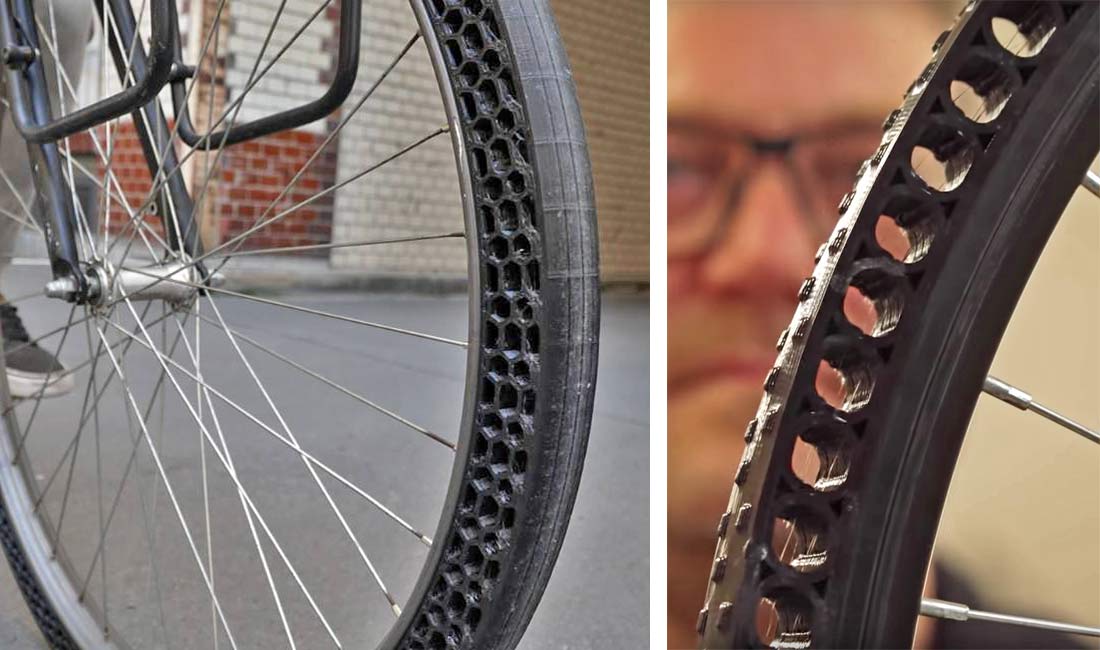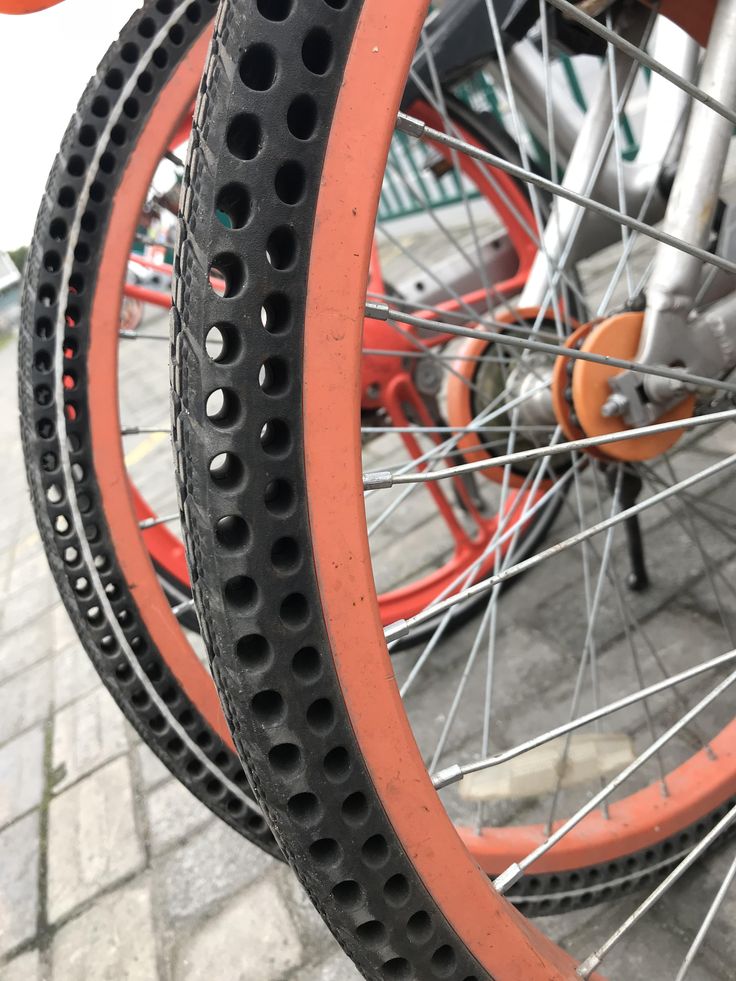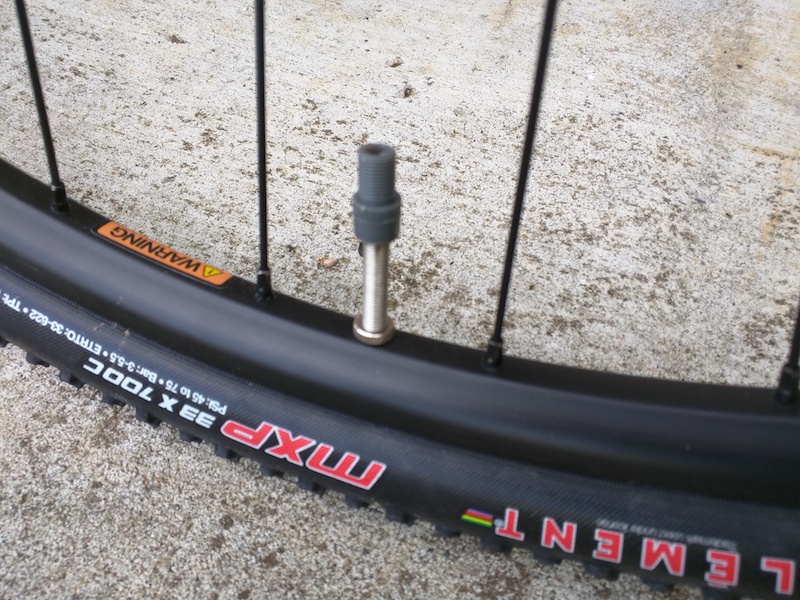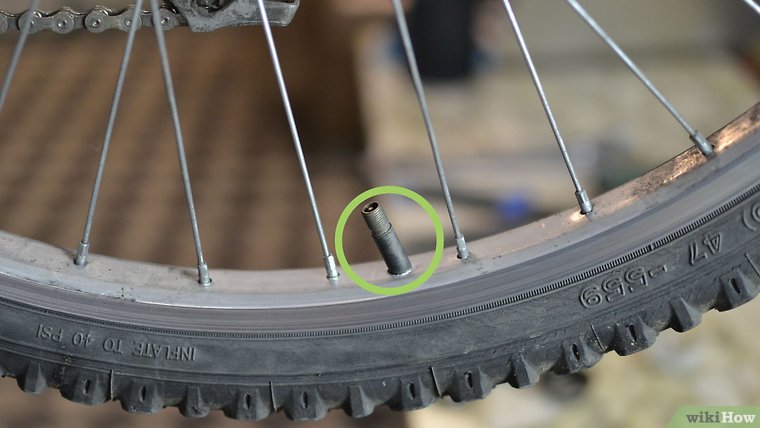I’ve often cycled past gas stations and wondered whether it would be possible to fill up my bike tires using the air compressors that you see on every forecourt. So I decided to do some research to see if it could be done.
The quick answer? Yes. But it comes with a large health warning attached. Why? Well, those air compressors aren’t regulated in the same way (or at all, in fact) like gas pumps are. So, unlike with gasoline, when you pump air using one of those compressors you can never be entirely sure how much air you’re going to get with each pull of the trigger. That’s fine if you’ve got a big car tire to inflate, but when you’ve got a more delicate bicycle inner tube then it can be very easy to pop it. If you’ve ever popped an inner tube through over-inflation you’ll know that it can give you quite a shock, both from the initial bang and then the lengthy walk home pushing your bike with the flat tire.
So, if you are stuck away from home with a deflated tire and your only option is to use a gas station pump, then first check that the attendant is happy for you to use it, and second, proceed with extreme caution. Remember that an under-filled tire is always better than a popped tire.
We’ll take a look at the methods of inflating tires with Schrader and Presta valves in a moment. We’ll then look at a couple of far superior options to ensure that you never have to risk using a gas station pump.
A better alternative to a gas station pump is the Lezyne Twin Kit CO2 Inflator. This ultra-compact tire inflator fits both Presta and Schrader valves, is super-simple to use and will get you back on the road FAST!
Image | Check prices | |
1. | View product | |
2. Brass Presta Valve Adapter | View product | |
2. Topeak Road Morph Pump with Gauge | View product |
First up, you need to determine what type of valve your bike tires have. The valve is the metal tube that pokes through the wheel rim towards the center of the wheel. There are two main types: Schrader and Presta. Schrader valves are the same type as you get on car tires. Presta valves are longer and thinner and have a locking nut towards the tip. You’ll often see Schrader valves on mountain bikes and Presta valves on road bikes.
The valve is the metal tube that pokes through the wheel rim towards the center of the wheel. There are two main types: Schrader and Presta. Schrader valves are the same type as you get on car tires. Presta valves are longer and thinner and have a locking nut towards the tip. You’ll often see Schrader valves on mountain bikes and Presta valves on road bikes.
If you have Schrader valves then it is a much simpler process to inflate your tires using a gas station pump as the nozzle of the air hose will fit your bike tires:
Gas station air hoses are all designed to fit on to Schrader valves as this is what car tires have. If you have Presta valves on your bike tires you will need to use an adapter to sit between the air nozzle and the valve to give an airtight seal. These adapters are not expensive, however, you will need to purchase one in advance as they are unlikely to be available for sale at the gas station when you need it.
These adapters are not expensive, however, you will need to purchase one in advance as they are unlikely to be available for sale at the gas station when you need it.
Buy one of these Presta valve adapters now.
Then keep it safe and ready to use, in one of your jersey pockets or tucked inside your bike saddlebag.
View Details on Amazon
How to inflate Presta valve with adapterThese adapters are very easy to use. Just unscrew the dust cap, loosen the Presta valve locking nut and screw the adapter on over the tip of the valve. You’re then ready to connect the air hose nozzle and (very carefully) inflate your tire. When you’re done, remove the adapter (putting it back in its safe place), tighten the valve locking nut, and screw the dust cap back on.
We’ve seen that, with care, you can use gas station air pumps to inflate your bicycle tires. The trouble is that sometimes gas stations are few and far between. If you can’t rely on having a handy gas station when you need to inflate your tires, what should you do?
The simple answer is to take a pump with you. There are lots of different bike pumps available and many are very small and powerful. We’ll take a look at two of my favorite options now. One requires some manual labor. One uses the magic of an air compressor packed into a tiny travel size. Let’s take a look.
There are lots of different bike pumps available and many are very small and powerful. We’ll take a look at two of my favorite options now. One requires some manual labor. One uses the magic of an air compressor packed into a tiny travel size. Let’s take a look.
Topeak Road Morph Pump with Gauge
Back in the day, bike pumps used to be huge things that never seemed to blow out more than an asthmatic puff of air at a time. Thankfully those days are gone and we have fantastic bike pumps like this one.
It fits onto your bike frame with the included mounting system, so you’ll never forget to take it out with you. When you need it, it works with both Presta and Schrader valves and can inflate tires up to 140 PSI. Yes, that will take some work, and you’ll probably need a Coffee ‘n’ Cake stop shortly after to recover, but then you’ll be back on the road. One clever feature of the pump is its fold-out foot and handgrip – these make it comfortable and stable to use.
View Details on REI
Lezyne Twin Kit CO2 Inflator
This is my absolute favorite piece of bike kit (possibly more than the bike itself…) This pump uses compressed cartridges of CO2 (it comes with 2 cartridges, so you’re good to go). These are used to blow air through the nozzle into your tires. One cartridge will inflate 1-2 tires fully, so I tend to take two cartridges and the nozzle when I go out on the bike. The kit is so tiny that you’ll forget you’ve got it with you (until you need it) and it won’t interfere with the snack-carrying capacity of your jersey pockets.
The air nozzle is easy to use and works with both Presta and Schrader style valves and replacement cartridges are easy and cheap to source online. Before I got one of these I wondered how good they would actually be. Earlier this year as I was inflating a tire in the middle of a mud bath in the midge-infested Scottish Highlands, I congratulated myself again for buying one of these. Inflation took a few seconds, there was no tiresome pumping, and I was away again pedaling to escape the flying beasties.
Inflation took a few seconds, there was no tiresome pumping, and I was away again pedaling to escape the flying beasties.
View Details
So, we’ve seen that, yes, it’s possible to pump up bike tires using a gas station air pump. I wouldn’t advise it though, because of the risks, so use it only as a last resort.
If you’ve got Schrader valves, then you’re good to go as these are the same valves as car tires have. If you’ve got Presta valves then you will need to buy an adapter beforehand.
There are better alternatives to gas station air pumps though. Ones that you can use on the many miles of road where there isn’t a gas station to be found for miles. These are designed to be used on bike tires so are safer to use.
If you’d like more detail on the difference between Schrader and Presta valves and a look at how the Presta adapters fit, then check out this video:
Happy cycling!
**Please note that our reviews are based on customer reviews, star ratings, and online complaints. Therefore, Bicycle Volt are in no way liable**
Therefore, Bicycle Volt are in no way liable**
I headed off from my house one Saturday early in my biking career, drooling with excitement for the mountain bike ride I’d been awaiting all week. Then, before I had reached the trailhead, I noticed my rear tire was significantly low. I felt like I was riding through mud – on the pavement! Remembering a gas station with an air pump on my way to the trailhead, I figured I could easily pump up my tire without a wasted trip back to my house.
But, when I tried to inflate my mountain bike tire… AAACK! Foiled! The gas station had a standard car pump and, new biker that I was, I forgot my bike tires have a presta valve. A week of hungering for a mountain bike ride… RUINED! All because of a puny little valve. Oh, the angst. Do NOT let this happen to YOU!
Unless you grew up biking, most of us are so familiar with car tire valves, we assume it’s the only type of valve. In truth, car tires use what’s called a Schrader valve. It’s about the diameter of a pencil and has a tiny “button” in the center that, when pressed, allows air in or out, but holds air pressure relatively steady when not compressed.
In truth, car tires use what’s called a Schrader valve. It’s about the diameter of a pencil and has a tiny “button” in the center that, when pressed, allows air in or out, but holds air pressure relatively steady when not compressed.
Presta valves, on the other hand, are significantly skinnier than Schrader valves. They don’t have a button in the center of the valve and instead have an attached screw mechanism at the tip. When screwed closed, it holds air pressure in the tire. When unscrewed, you can pump air in or release air out.
Presta ValveCurrently, presta valves are the most common type of valve on high-end mountain bikes. Racers and high performance cyclists prefer them. They’re becoming increasingly common – even on mountain bikes on the low-end of the price spectrum.
Why, you ask. (Perhaps with a significant number of swear words as you kick your flat mountain bike tire or throw your useless Schrader pump.) Why use an uncommon, obscure valve that doesn’t fit a standard pump? Is it just to make mountain bike newbies suffer? Why? Why?
No, it’s not just to frustrate you.
Presta valves are generally more reliable and allow pumping your tires to a more precise pressure. By virtue of design, all Schrader valves release tiny amounts of air over time, requiring occasional “topping off”. Having a cap on the valve can significantly decrease the air loss, but it still means, at any given moment, your tire may not have the pressure you pumped it to.
A casual mountain bike rider may not know what pressure they should be riding or even notice when the pressure is off. But for high-speed riders, tire pressure can have a significant impact on speed, race performance and riding safety.
The screw on the tip of the presta valve allows a rider to close off the tube at the desired pressure and not require a cap. Barring an unnoticed leak or a puncture during a ride, the tire will now reliably hold the pressure you want.
You can inflate a presta valve with a common air pump, such as at a gas station or portable air compressor. However, you need an adaptor that’s ridiculously small in size but huge in importance: a presta valve adaptor.
However, you need an adaptor that’s ridiculously small in size but huge in importance: a presta valve adaptor.
Here are the steps to inflate a presta valve with a standard pump:
Since more and more mountain bike tires use presta valves, most bike pumps are either universal (meaning one hole works on both presta and Schrader valves) or they have two separate holes, one for each valve type. However, you should always carry a valve adaptor when you ride for situations when a standard pump is the only option. Some cyclists do this by keeping a valve adaptor screwed on their tire valve all the time. Just make sure the valve is screwed closed before putting the adapter on!
Presta valve adapters are extremely tiny and portable. This also means they’re easy to lose. The good news is they’re fairly cheap. I usually buy a handful at a time and keep one in my garage bike tools and one in my portable tool kit for rides. Having one in your glove box isn’t a bad idea, either!
This also means they’re easy to lose. The good news is they’re fairly cheap. I usually buy a handful at a time and keep one in my garage bike tools and one in my portable tool kit for rides. Having one in your glove box isn’t a bad idea, either!
All bike shops sell valve adapters and some general sporting goods shops and hardware stores carry them as well. You can also buy valve adapters online easily and cheaply.
This simple question actually does not have a straightforward answer. The simple rule is to refer to the tire manufacturer’s specs on tire pressure that are printed on the sidewall of your tires. Consensus of riders is that mountain bike pressure should be 30 psi on the front tire and 33 psi for the rear tire. This information should serve you well if you have only a casual interest in mountain biking and are doing entry-level to intermediate trails two or three times a month.
However, if you spend a significant amount of time on your bike (and an equally significant amount of time dealing with pinch flats, blowouts or skidding out on corners), you’ll want to dive deeper into the science of bike tire pressure. DIY Mountain Bike has a fabulous, in-depth article and survey results examining appropriate bike tire pressure.
DIY Mountain Bike has a fabulous, in-depth article and survey results examining appropriate bike tire pressure.
The fastest and easiest (and cheapest) way to check your tire is with your hand. When you squeeze it, it should be hard in the center with only a tiny bit of give farther out on the tire near the treads. A hand test, however, is – not surprisingly – not very accurate!
If you want to be precise, a tire pressure gauge will be necessary. But be warned: tire pressure gauges are notoriously unreliable and the sensitive sensors are easily broken. For my recommendation, read my tire pressure gauge product review.
If you’re in a pinch (perhaps literally!), and you don’t have a universal pump or a valve adapter, you can modify a tube cap to create a functional adapter using a presta valve CAP.
 Find the place on the valve cap where it gets smaller. Cut at that spot with scissors or whatever you have that will do the trick. Throw the tiny tip away.
Find the place on the valve cap where it gets smaller. Cut at that spot with scissors or whatever you have that will do the trick. Throw the tiny tip away.Remember to screw the tire valve shut after inflating! I know you’re tired of hearing that, but it’s important.
Now that you know everything you need to about how to inflate a presta mountain bike tire, you’ll never find yourself hungering for a ride and find yourself deterred by a standard tire pump!
And don’t forget to screw the presta valve closed…
Professional writer Kat Jahnigen was 2 miles from the nearest village – and roughly 2,310 miles – from the nearest English-speaking town – when her bike tire burst. At that time, she was a college student on a bike trip across the desolate, rocky island of Crete. It suddenly occurred to her that it would’ve been good to learn some basic bike repairs before setting off on a solo bike trip.
Check out Kat’s website WriteHire at writehire.net.
Maintaining tire pressure is one of the most important things in basic bike maintenance and is often overlooked. Meanwhile, maintaining the correct pressure in the bicycle tires will make the ride safe and greatly extend the life of the bicycle components.
1. When riding on underinflated tires, most of the cyclist's energy is wasted in overcoming rolling resistance and slowing down.
2. Properly inflated tires will prevent the tire from being pinched by the rim when driving over curbs or railroad crossings.
3. Riding on tires that have sufficient pressure will allow them to be used much longer, eliminating wear and cracks on the sides.
4. Having a properly inflated tire protects the wheel rims from warping and denting. All shocks and loads from potholes and objects on the road will be absorbed by the tire.
5. Properly inflated tires also make it easier to steer and control the bike, especially on tight turns.
6. Sufficient pressure will greatly reduce the chance of a puncture.
Even the highest quality cameras lose pressure by about 1 bar per month (1 bar = 0.98692 atmospheres) - this is considered normal. Unlike car tires, bicycle tires have much more pressure and less wall thickness. At higher pressure, its losses increase accordingly. In the normal condition of the chamber and the valve, it is enough to pump up and adjust the pressure in the wheel once a month.
It is not possible to give a clear recommendation to what pressure the tires should be inflated. It mainly depends on the total weight of the cyclist and luggage. In the case of a bicycle, a person with things has a weight much greater than the weight of the vehicle on which he rides, i.e., a bicycle.
In addition, each person, especially the experienced one, has his own individual preference for the pressure value. The permissible pressure range is marked by the manufacturer on the tire sidewall. You can deduce the rule: the higher the air pressure, the lower the rolling resistance and the less likely it is to puncture. The lower the pressure, the more comfortable the ride and the better the grip.
The permissible pressure range is marked by the manufacturer on the tire sidewall. You can deduce the rule: the higher the air pressure, the lower the rolling resistance and the less likely it is to puncture. The lower the pressure, the more comfortable the ride and the better the grip.
Another recommendation to maintain the required pressure in the tires of a bicycle offered by manufacturers: for example, you have derived a certain pressure value for yourself. When carrying luggage, for each additional kilogram it is necessary to increase the pressure by 1%. And the most important rule: in any case, the tire pressure should not be higher or lower than the maximum or minimum value indicated by the manufacturer on the side surface.
Bicycle chain wear. Ideally, the new chain should be 12.7 times the number of links in the chain. How to know the wear condition of the chain in order to control the situation and change the chain in time, extending the life of the cassette?…
Bicycle preventive lubrication chart. Front and rear derailleurs. The clarity of gear shifting directly depends on their smooth running. Especially the rear derailleur, which moves in three planes. It is also necessary to lubricate the two rollers of the chain tensioner...
Front and rear derailleurs. The clarity of gear shifting directly depends on their smooth running. Especially the rear derailleur, which moves in three planes. It is also necessary to lubricate the two rollers of the chain tensioner...
How to avoid a puncture. Use a sealant that is poured into the chamber and securely seals the hole when punctured. 500 ml of sealant is enough for two wheels. Last season I did not have a single puncture and I attribute this precisely to the use of sealant ...
Tire and tube replacement. Turn the bike upside down. If the surface is flat, the bike is stable on the saddle and handlebars. Often repairs take place on the road, so you need to make sure that when turning over, do not damage the brake levers and shifters ...
Garage for a bicycle on the balcony winter time. In the summer it was still possible to put up with his presence in the apartment, but in winter, even though he reminded me of my cycling exploits with his appearance . ..
..
admin
As a rule, the front tires of a bicycle last three times longer than the rear ones. This is because the rears carry much more weight than the fronts. The second reason for increased rear tire wear is that the rear wheel of the bike is the drive wheel. The wear bias is even greater on bikes that use rear brakes.
Very smart and practical cyclists (forgive them), and sometimes even “professional” bike mechanics (but they don’t), can’t think of anything more original to deal with the above phenomenon, how to rearrange bicycle tires in places.
That is, they install a less worn tire from the front wheel to the rear, and a rear tire that lives out its last days on the front wheel. The main purpose of such actions is to equalize the wear of both tires. This is a serious mistake and should not be made!
Probably the only time you can change bike tires is if you have to replace a rear tire for any reason. For example, when driving, you felt that something was wrong with it, or visually it was completely worn out and had obvious defects, then you can do this. When using the same tires at the rear and front, you can rearrange the old front tire and the new one on the front wheel.
For example, when driving, you felt that something was wrong with it, or visually it was completely worn out and had obvious defects, then you can do this. When using the same tires at the rear and front, you can rearrange the old front tire and the new one on the front wheel.
The reason for such actions is very banal - it is the safety of the cyclist. The good condition of the front tire is much more important for the same safety than the rear. Therefore, it is better to put a more reliable tire in front. In the event of a rear tire rupture, it is much easier for the cyclist to handle the bike and stop it. When a front tire ruptures, first of all, control of the bike is lost, and the consequences can be sad.
Sheldon Brown
Bicycle tire damage. Wearing a bicycle tire is a rather complicated process. It is generally accepted that the main wear of the tire falls on the place where it touches the ground. But, wear also occurs where the tire meets the wheel rim, especially when riding on tires with…
How to prolong the life of a bicycle tire.